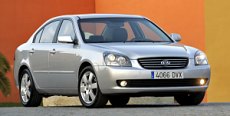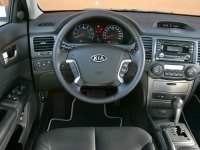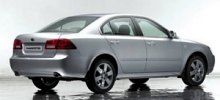|
 Seeing
Kia Magentis, I recalled how Japanese cars looked a couple of decades
ago. Every developing car maker started business by making cheap small
cars. They made a fortune in the United States, then invested the money
to develop larger cars. At first, they stressed on value for money,
offering a lot of metal and standard equipment at bargain price. Then
they improved mechanicals and performance to world standard. As their
standards and ambitions raised, they needed to move upmarket in order
to distant themselves from other cheap car makers. Thus they started
paying attention to design, quality packaging and innovations. If they
do it right, they could become another world class manufacturer. Seeing
Kia Magentis, I recalled how Japanese cars looked a couple of decades
ago. Every developing car maker started business by making cheap small
cars. They made a fortune in the United States, then invested the money
to develop larger cars. At first, they stressed on value for money,
offering a lot of metal and standard equipment at bargain price. Then
they improved mechanicals and performance to world standard. As their
standards and ambitions raised, they needed to move upmarket in order
to distant themselves from other cheap car makers. Thus they started
paying attention to design, quality packaging and innovations. If they
do it right, they could become another world class manufacturer.
 Unfortunately,
Kia has not yet entered the last stage. Look at the dull styling of
Magentis and you will understand. It is so boring, so characterless.
Obviously Kia didn't spend much money hiring good designers. Open the
doors, the ugly dashboard molding is even more appalling. Even if you
don't care about shinny hard plastics and fake alloy, you won't please
with the cheap air vents and switch gears, as is the low rent leather
upholstery. Yes, it does offer a lot of space and a lot of free
equipment, but so what? Unfortunately,
Kia has not yet entered the last stage. Look at the dull styling of
Magentis and you will understand. It is so boring, so characterless.
Obviously Kia didn't spend much money hiring good designers. Open the
doors, the ugly dashboard molding is even more appalling. Even if you
don't care about shinny hard plastics and fake alloy, you won't please
with the cheap air vents and switch gears, as is the low rent leather
upholstery. Yes, it does offer a lot of space and a lot of free
equipment, but so what?
I guess most shoppers will leave Kia's showrooms after seeing the above
scenes. However, if they are mercy enough to stay longer, they may
discover better things lie on the mechanical aspect. The Magentis rides
on struts and multi-link suspensions like classy European cars, at
least according to spec. It employs some really world-class engines,
such as a sophisticated 2-litre common-rail turbo diesel engine, a
family of 1.8, 2.0 and 2.4-litre all-aluminum CVVT four-cylinder
engines jointly developed by Chrysler, Mitsubishi and Hyundai, and a
2.7-litre DOHC CVVT V6. The latter mates with a decent 5-speed
automatic gearbox. Many of these parts were either carried over or
derived from Hyundai Sonata, although Kia claims it developed the
platform independently by itself.
 In terms
of engine refinement and flexibility, the Magentis does match the world
standard. However, performance is just average because the car is
rather heavy. For example, a 2.0-litre car with manual transmission
takes 9.6 seconds to accelerate from 0-60 mph. That's 0.8 seconds
slower than Volkswagen Passat 2.0 and Ford Mondeo 2.0. Even the
flagship V6 needs 8.5 seconds, which is disappointing. In terms
of engine refinement and flexibility, the Magentis does match the world
standard. However, performance is just average because the car is
rather heavy. For example, a 2.0-litre car with manual transmission
takes 9.6 seconds to accelerate from 0-60 mph. That's 0.8 seconds
slower than Volkswagen Passat 2.0 and Ford Mondeo 2.0. Even the
flagship V6 needs 8.5 seconds, which is disappointing.
Chassis dynamics is even worse. Like many Japanese cars of the past,
the suspensions are too soft, generating a lot of roll and pitch to
discourage the driver. Enter a corner and you will find it understeer
early on. Simultaneously, the steering delivers no road feel to the
driver. Obviously, this is one of the least interesting drives in the
class, and probably the worst in recent years.
Whether Kia can elevate to the aforementioned last stage is yet to be
seen. But from the Magentis we can see there is still a long long way
to go. |